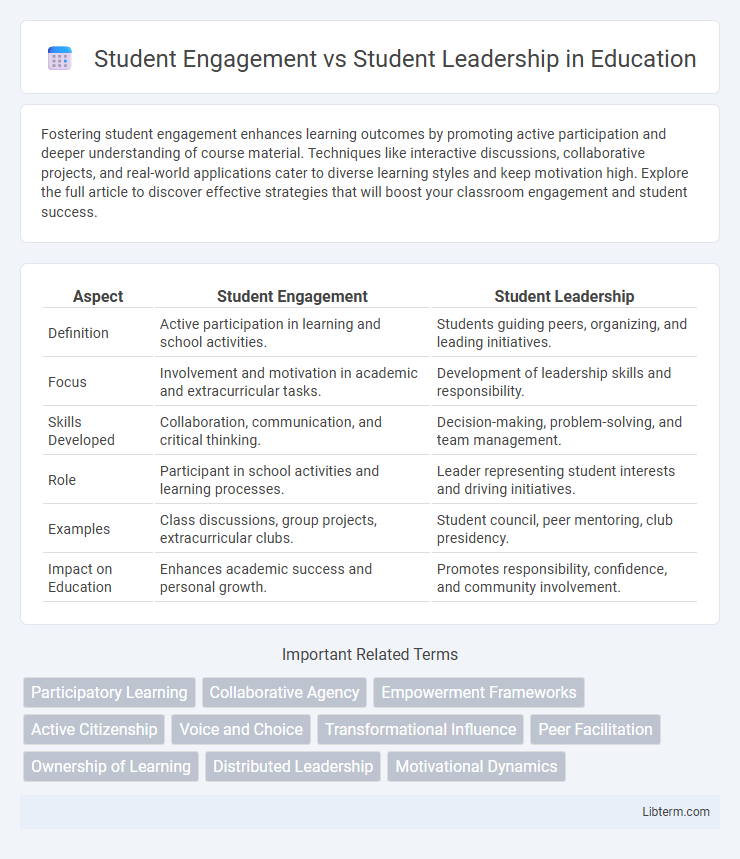Fostering student engagement enhances learning outcomes by promoting active participation and deeper understanding of course material. Techniques like interactive discussions, collaborative projects, and real-world applications cater to diverse learning styles and keep motivation high. Explore the full article to discover effective strategies that will boost your classroom engagement and student success.
Table of Comparison
| Aspect | Student Engagement | Student Leadership |
|---|---|---|
| Definition | Active participation in learning and school activities. | Students guiding peers, organizing, and leading initiatives. |
| Focus | Involvement and motivation in academic and extracurricular tasks. | Development of leadership skills and responsibility. |
| Skills Developed | Collaboration, communication, and critical thinking. | Decision-making, problem-solving, and team management. |
| Role | Participant in school activities and learning processes. | Leader representing student interests and driving initiatives. |
| Examples | Class discussions, group projects, extracurricular clubs. | Student council, peer mentoring, club presidency. |
| Impact on Education | Enhances academic success and personal growth. | Promotes responsibility, confidence, and community involvement. |
Understanding Student Engagement
Student engagement encompasses the emotional, behavioral, and cognitive investment students make in their learning process, directly influencing academic achievement and retention rates. It involves active participation in classroom activities, collaboration with peers, and intrinsic motivation to master subjects, forming the foundation for effective educational experiences. Understanding student engagement requires analyzing factors such as interaction frequency, attentiveness, and emotional connection to the curriculum, which differ fundamentally from the skills and responsibilities associated with student leadership.
Defining Student Leadership
Student leadership involves actively guiding and influencing peers through roles that require responsibility, decision-making, and collaboration within educational settings. It emphasizes developing skills such as communication, problem-solving, and project management to inspire collective achievement and foster a positive campus culture. Unlike student engagement, which centers on participation in activities, student leadership specifically pertains to taking initiative and stewardship in organizing, directing, and impacting school or community initiatives.
Key Differences Between Engagement and Leadership
Student engagement involves active participation and emotional investment in learning activities, while student leadership centers on guiding peers and influencing group dynamics. Engagement emphasizes involvement and motivation in educational tasks, whereas leadership prioritizes decision-making, responsibility, and mentorship within student groups. Both are critical for personal development but differ fundamentally in roles and objectives.
Importance of Student Engagement in Education
Student engagement in education significantly enhances academic achievement, motivation, and retention by actively involving students in learning activities tailored to their interests and needs. Active engagement fosters critical thinking, collaboration, and communication skills essential for lifelong learning and personal development. Schools that prioritize student engagement create inclusive environments where learners feel valued and empowered, resulting in improved attendance and reduced dropout rates.
Impact of Student Leadership on School Culture
Student leadership significantly shapes school culture by fostering a sense of responsibility, collaboration, and inclusivity among students, which enhances overall engagement and academic motivation. Effective student leaders act as role models, facilitating communication between peers and staff, and driving initiatives that promote positive behavioral norms. Research indicates that schools with strong student leadership programs experience increased student participation, improved school climate, and higher levels of community involvement.
How Engagement Fosters Leadership Skills
Student engagement fosters leadership skills by promoting active participation, collaboration, and critical thinking in academic and extracurricular activities. Engaged students develop communication, problem-solving, and decision-making abilities essential for effective leadership. This active involvement creates a foundation for confidence and responsibility, empowering students to take on leadership roles.
Challenges in Promoting Student Engagement
Promoting student engagement faces challenges such as varying levels of motivation, limited time due to academic workload, and insufficient resources for inclusive activities that resonate with diverse student interests. Unlike student leadership, which involves designated roles and responsibilities, engagement requires continuous, active participation from all students, making consistent involvement difficult to maintain. Addressing these obstacles demands targeted strategies to foster a supportive environment that encourages collaboration, creativity, and meaningful interaction.
Strategies to Cultivate Student Leadership
Cultivating student leadership involves implementing strategies such as providing mentorship programs, offering leadership training workshops, and creating opportunities for students to lead projects or clubs. Encouraging student autonomy and responsibility enhances their decision-making skills and builds confidence. Establishing a supportive school culture that recognizes and rewards leadership contributions fosters ongoing student motivation and active participation.
Measuring Success: Engagement vs Leadership Outcomes
Measuring student engagement focuses on tracking participation rates, attendance, and involvement in academic and extracurricular activities, reflecting how connected students feel to their institution. In contrast, assessing student leadership emphasizes evaluating the development of leadership skills, decision-making abilities, and the measurable impact of student-led initiatives on the campus community. Combining metrics from both areas offers a comprehensive view of student growth, balancing active involvement with leadership effectiveness.
Integrating Engagement and Leadership for Student Development
Integrating student engagement and leadership fosters holistic student development by combining active participation with skill-building opportunities. Engagement initiatives such as clubs, events, and collaborative projects provide practical contexts for students to practice leadership, enhancing communication, decision-making, and teamwork abilities. This synergy cultivates empowered students who contribute meaningfully to campus culture while preparing for future professional roles.
Student Engagement Infographic

 libterm.com
libterm.com